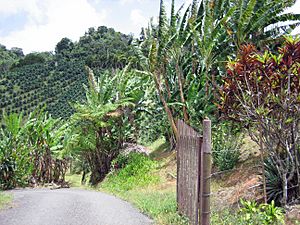Coffee production in Puerto Rico facts for kids
Coffee production in Puerto Rico has a long and interesting story. For a long time, coffee was a very important crop on the island. It was especially popular when Spain ruled Puerto Rico. But after the United States took over in 1898, coffee farming slowed down. Today, there's a new excitement for special, high-quality coffee. Many old coffee farms, called haciendas, are opening again. People say Puerto Rican coffee is smooth and sweet.
History of Coffee in Puerto Rico
Coffee first came to Puerto Rico in 1736. It was brought from a nearby island called Martinique. At first, it was a small crop, mostly for people living on the island. But by the late 1700s, Puerto Rico was growing over a million pounds of coffee each year!
By the late 1800s, coffee farming was at its peak. Puerto Rico became the world's seventh largest coffee producer. A town called Utuado was a very important coffee area before 1898. This fast growth happened because people from Europe came to the island. They brought their knowledge and skills for growing coffee.
In 1898, the United States took control of Puerto Rico from Spain. After this, coffee farming went down. Farmers started to focus more on growing sugarcane for money.
However, coffee farming is now making a comeback! Many old hacienda estates are reopening. New areas are also being used to grow coffee. These new farms are often in the Cordillera Central mountains. The soil there is rich from volcanoes, which is great for growing high-quality coffee.
How Coffee is Produced
Coffee farms in Puerto Rico are found all over the island. They are mostly in the western central mountains. These farms are usually between 2,400 and 2,780 feet high. Some higher places, like Ponce, can grow coffee up to 4,390 feet.
The main areas for coffee production are in towns like Yauco, Adjuntas, San Sebastián, Lares, and Las Marías. These are in the northwestern central part of Puerto Rico.
In recent years, some things have made coffee production harder:
- Cloudy weather: Too much cloud cover can affect the plants.
- Climate change: Changes in weather patterns can harm crops.
- High costs: It can be expensive to grow coffee.
- Not enough pickers: Sometimes, about half of the coffee beans are not picked. This is because there are not enough workers.
The main type of coffee grown is called Coffea arabica. Popular kinds of this coffee include Bourbon, Typica, Pacas, and Catimor.
About one-third of the coffee grown in Puerto Rico is used by people on the island. Some coffee is also brought in from the Dominican Republic and Mexico. This imported coffee is often used in fast-food places and small cafes. Only a small amount of Puerto Rican coffee is sent to other countries.
ko:푸에르토리코 요리


